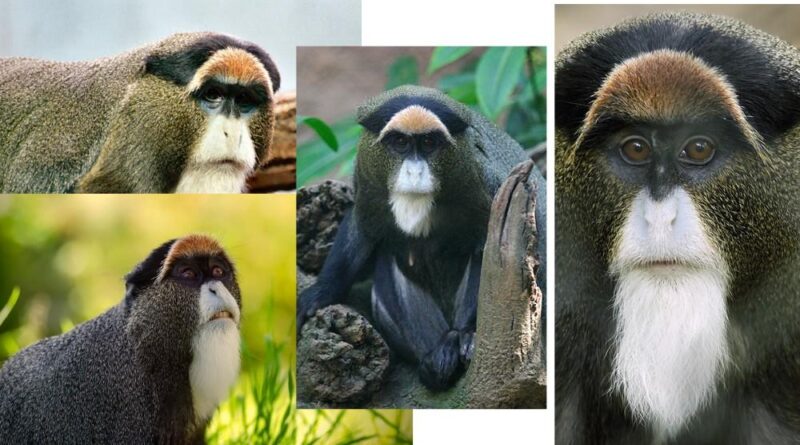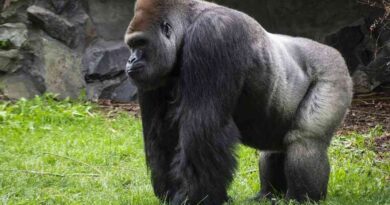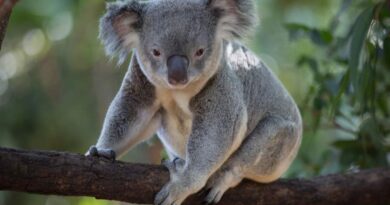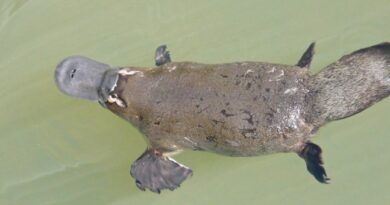Fun Facts About De Brazza’s Monkeys You Didn’t Know
De Brazza’s monkeys stand among the most distinctive primates in Central Africa’s forests. These remarkable creatures feature striking white facial hair, dark caps, and chestnut-colored backs that make them unique among Old World monkeys. Their identification requires careful observation and knowledge of specific characteristics that set them apart from other forest-dwelling primates.
Wildlife observers need several key skills to successfully identify De Brazza’s monkeys in their natural habitat. This guide covers essential physical characteristics, preferred habitats, behavioral patterns, and practical observation techniques. Understanding these elements helps ensure accurate identification during field observations and contributes to ongoing conservation efforts.
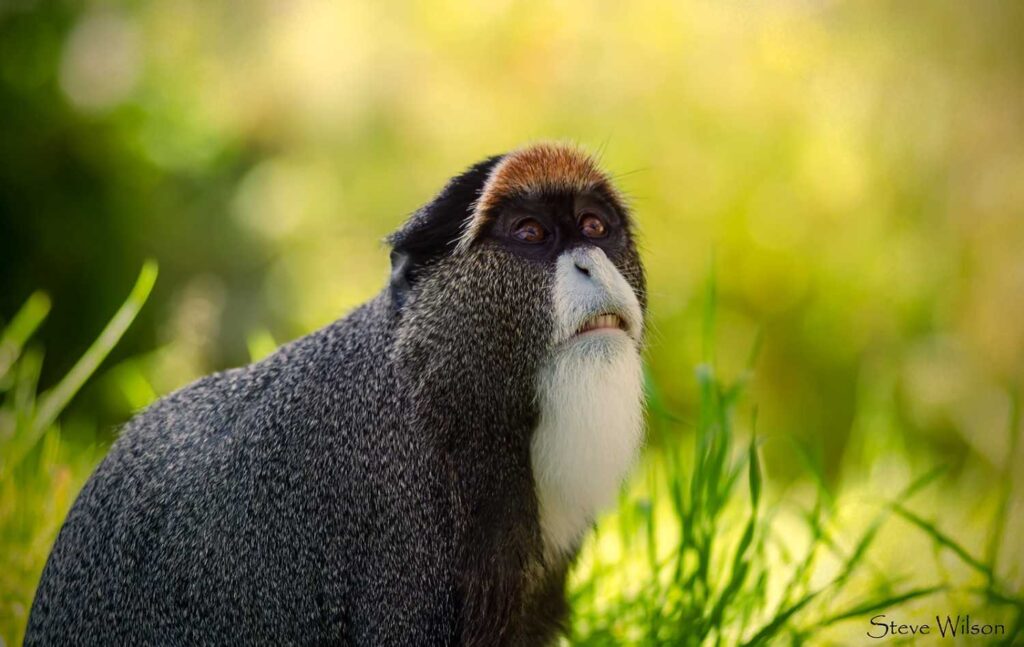
Physical Characteristics of De Brazza’s Monkeys
The physical characteristics of De Brazza’s monkeys make them one of the most recognizable primates in their habitat range. Their distinct features serve as reliable markers for identification in the wild.
Distinctive facial features
De Brazza’s monkeys possess a striking facial appearance characterized by an orange crescent-shaped crest positioned above apricot-colored eyes. Their most notable feature is a prominent white beard extending from the nose, complemented by a black crown. This distinctive combination of facial markings has earned them the informal nickname “Ayatollah Monkey.”
Body coloration and markings
The body of a De Brazza’s monkey displays a complex pattern of coloration:
- Speckled gray agouti fur covers most of the body.
- Reddish-brown coloring appears on the back.
- Black coloration on all limbs and tail.
- White rump with distinctive stripes on thighs.
- Well-developed cheek pouches for food storage.
Size and sexual dimorphism
De Brazza’s monkeys exhibit significant sexual dimorphism, representing the most pronounced size difference among all guenon species. Their physical measurements vary considerably between males and females:
| Characteristic | Males | Females |
| Body Length | 25 inches (63.5 cm) | 16 inches (40.6 cm) |
| Weight | 15-17 pounds (6.8-7.7 kg) | 8 pounds (3.6 kg) |
Males display additional distinguishing features, including a prominent blue scrotum, while females have a red perianal region and visible nipples. Juveniles initially lack the darker colors on their extremities but maintain the white stripes and red rump characteristic of the species. Infants appear distinctly different, showing a uniform brown agouti coloration with only a small beard, gradually developing their adult markings between 6-12 weeks of age.
The transition to adult coloration occurs systematically, with the characteristic beard and mustache appearing at approximately three weeks of age. The complete adult coloration pattern typically develops between two to three months, marking the transition from infant to juvenile stage.
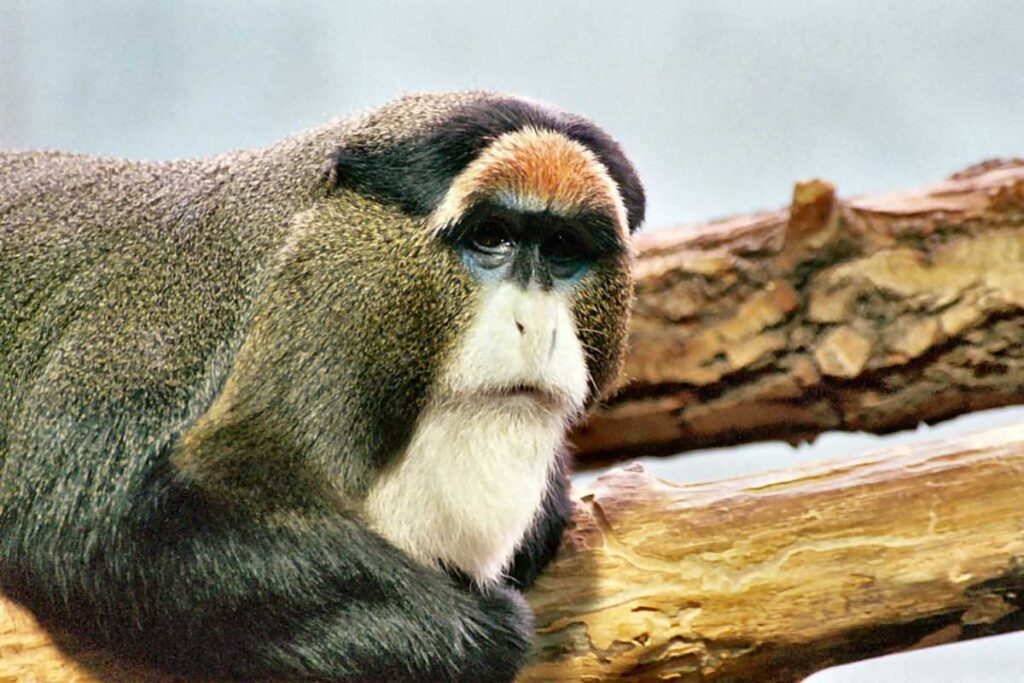
Habitat and Distribution
Understanding the habitat preferences and distribution patterns of De Brazza’s monkeys is crucial for successful identification in their natural environment. These elusive primates occupy specific ecological niches across Central Africa, demonstrating clear preferences for particular environments and locations.
Preferred ecosystems
De Brazza’s monkeys thrive in diverse forest environments, including:
- Dense swamp forests with thick vegetation.
- Lowland tropical forests with substantial canopy cover.
- Mountain forests with bamboo undergrowth.
- Wetland-adjacent woodlands.
These primates primarily occupy the lower canopy of these forests, preferring areas with dense vegetation that provides both protection and sustenance. Their adaptation to various forest types demonstrates their ecological flexibility while maintaining specific habitat requirements.
Geographic range in Central Africa
The distribution of De Brazza’s monkeys spans a significant portion of Central Africa, encompassing multiple countries and ecological zones:
| Region | Countries |
| Western Range | Cameroon, Gabon, Equatorial Guinea |
| Central Range | Congo, Democratic Republic of Congo, Central African Republic |
| Eastern Range | Uganda, Kenya, Ethiopia, South Sudan |
| Southern Range | Angola |
Recent observations suggest potential populations in Tanzania, though these reports remain unconfirmed. Their presence across such diverse geographical areas indicates their adaptability to various environmental conditions while maintaining specific habitat preferences.
Proximity to water sources
De Brazza’s monkeys exhibit a strong affinity for water-adjacent habitats, earning them the nickname “swamp monkeys.” Their relationship with water sources is characterized by several key aspects:
- Distance limitations: These primates rarely venture beyond 1 kilometer from water sources, maintaining close proximity to rivers and tributaries.
- Swimming capabilities: Unlike many other primates, De Brazza’s monkeys are accomplished swimmers, frequently utilizing water bodies within their territory. This unique adaptation allows them to access food resources and escape predators effectively.
- Habitat selection: Their territories consistently include at least one permanent water source, typically rivers or substantial streams. This water-centric habitat selection influences their daily movements and foraging patterns.
The combination of dense forest cover and reliable water sources creates ideal conditions for these primates, supporting their survival strategies and social behaviors. Their presence near water bodies also contributes to seed dispersal throughout riparian zones, making them important contributors to forest ecosystem dynamics.
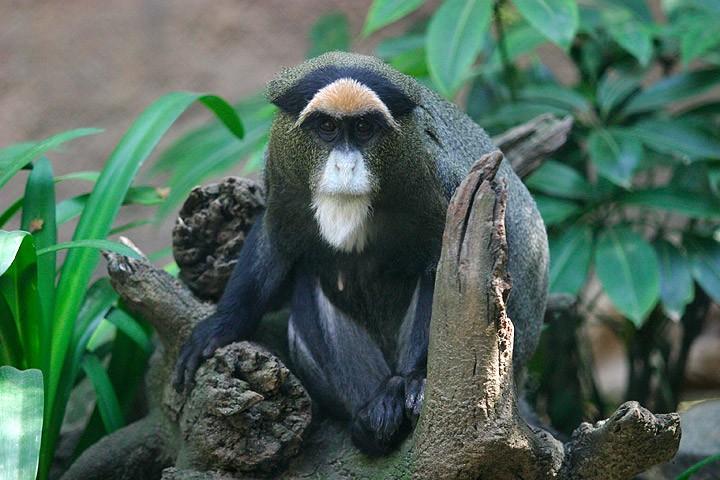
Behavioral Traits for Identification
Observing specific behavioral patterns is crucial for identifying De Brazza’s monkeys in their natural habitat. These primates exhibit distinct daily routines and social behaviors that set them apart from other forest-dwelling species.
Foraging patterns
De Brazza’s monkeys follow a predictable daily foraging schedule, making them easier to locate during specific times. They emerge to forage twice daily:
- Dawn foraging session in early morning hours.
- Dusk foraging period before nightfall.
- Mid-day rest periods in dense vegetation.
These primates demonstrate unique feeding behavior by storing food in their well-developed cheek pouches, allowing them to quickly gather nutrients and retreat to safety. They primarily utilize the lower canopy and forest floor during these foraging sessions, moving efficiently on all four limbs.
Social structure and group size
De Brazza’s monkeys maintain distinctively small social groups compared to other guenon species. Their troops typically consist of 4-10 members, though some exceptional groups may reach 30-35 individuals. The social structure follows two primary patterns:
- Eastern African populations: Single male, multi-female groups with offspring.
- Western African regions (Gabon, Cameroon): Pair-bonded groups consisting of one male, one female, and their young.
Female members remain in their natal groups throughout their lives, while males disperse upon reaching sexual maturity (5-6 years). Solitary males do not form bachelor groups but may challenge established males for group leadership.
Unique communication methods
De Brazza’s monkeys employ sophisticated communication strategies that combine vocal and visual signals. Their communication methods include:
| Signal Type | Description | Purpose |
| Booming Calls | Deep, resonant vocalizations | Territory establishment, group cohesion |
| Alarm Barks | Short, sharp sounds | Predator warnings |
| Visual Displays | Head bobbing, staring | Threat communication |
| Silent Signals | Facial expressions, body postures | Intragroup communication |
Males produce distinctive booming calls during early morning hours, serving both territorial and group coordination functions. When faced with threats, particularly from crowned eagles, males emit specific alarm barks before engaging in defensive behaviors. Females contribute to group communication through quiet croaks during feeding and resting periods, while infants and juveniles produce shrill distress calls when separated from the group.
Unlike many other guenon species that form mixed-species associations, De Brazza’s monkeys display aggressive behavior toward other primates. The sole exception is their tolerance of certain colobine species that do not compete for the same resources. This territorial behavior, combined with their cryptic nature, makes their vocalizations a crucial tool for identifying their presence in dense forest environments.
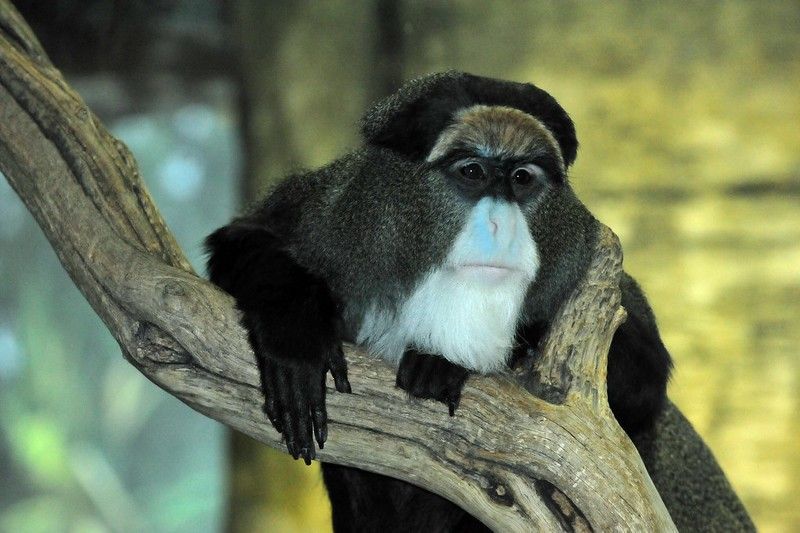
Tips for Spotting De Brazza’s Monkeys
Locating and identifying De Brazza’s monkeys requires specific strategies due to their secretive nature and cryptic behavior patterns. Success in spotting these elusive primates depends on understanding their daily routines and employing appropriate observation techniques.
Best time of day for observation
De Brazza’s monkeys follow consistent activity patterns that make certain times optimal for observation:
- Dawn Period (5:30 AM – 7:30 AM): Peak foraging activity
- Dusk Period (4:30 PM – 6:30 PM): Secondary feeding session
- Early Morning (7:30 AM – 9:30 AM): Social interactions
- Late Afternoon (3:30 PM – 4:30 PM): Movement between feeding sites
During midday hours, these primates typically retreat to dense vegetation, making observation significantly more challenging. Weather conditions also influence activity patterns, with overcast days occasionally extending active periods.
Recommended equipment
Successful observation of De Brazza’s monkeys requires specific equipment to overcome the challenges of forest environments:
| Equipment Type | Specifications | Purpose |
| Binoculars | 8×42 or 10×42 magnification | Detailed observation while maintaining distance |
| Camera | Long zoom lens (300mm minimum) | Documentation and identification |
| Field Notebook | Waterproof pages | Recording behaviors and locations |
| GPS Device | Water-resistant model | Marking observation points |
| Clothing | Dark, non-reflective materials | Minimizing visibility |
Patience and stealth techniques
De Brazza’s monkeys employ sophisticated defense mechanisms that require specific observation strategies:
- Stationary Observation
- Select a concealed position near water sources.
- Maintain complete stillness for extended periods.
- Position yourself downwind to prevent detection.
- Avoid sudden movements that might trigger freezing behavior.
- Movement Techniques
- Walk slowly and deliberately.
- Pause frequently to scan the canopy.
- Step carefully to minimize ground noise.
- Maintain regular breathing to reduce movement.
- Response to Detection
- If the monkeys freeze, remain motionless.
- Wait for natural resumption of activity.
- Avoid direct eye contact which may be perceived as threatening.
- Maintain your position even if the primates appear to have departed.
- Location Strategy
- Focus on areas with dense vegetation.
- Monitor locations near permanent water sources.
- Watch for movement in lower canopy levels.
- Listen for distinctive booming calls during early morning.
- Documentation Approach
- Record observation times and locations.
- Note behavioral patterns and group sizes.
- Document any unique markings or features.
- Track movement patterns between observations.
The success rate for spotting De Brazza’s monkeys increases significantly when observers understand their freeze response mechanism. These primates can remain motionless for up to eight hours when they detect potential threats. This behavior, combined with their natural camouflage, makes patient observation essential for successful identification.
Experienced observers recommend maintaining observation positions for at least two hours during peak activity periods. This duration allows sufficient time for the monkeys to resume normal behavior if they have detected human presence. Water proximity plays a crucial role in observation success, as these primates rarely venture more than one kilometer from permanent water sources.
Understanding their social dynamics also aids in identification. While De Brazza’s monkeys are generally hostile toward other primate species, they maintain peaceful relationships with colobus monkeys. This unique association can serve as an additional indicator of their presence in an area.
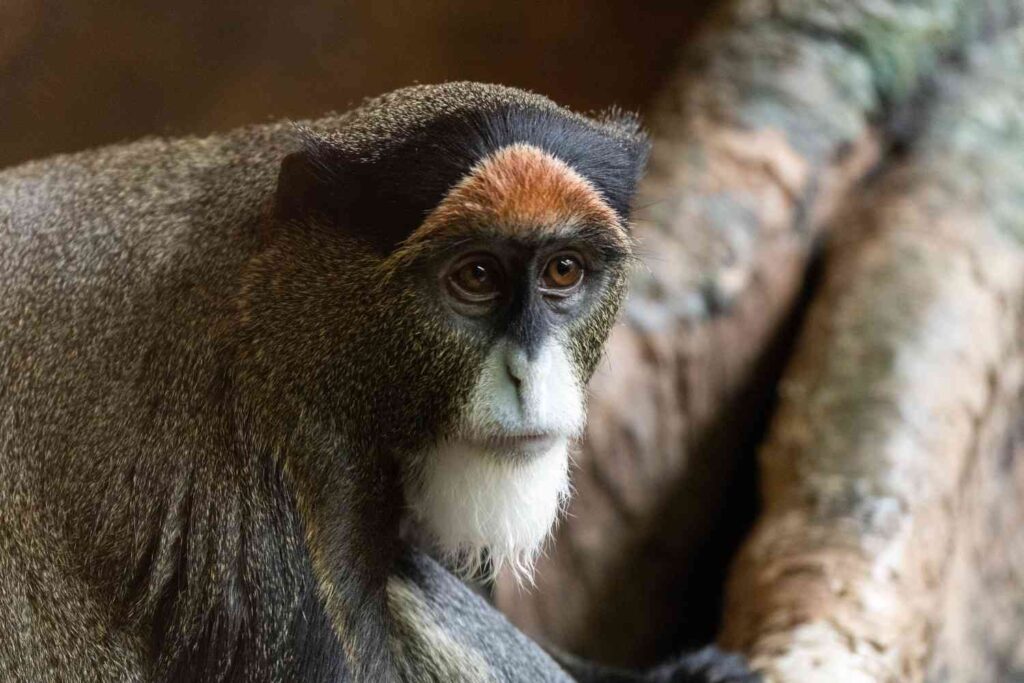
Overall Review
De Brazza’s monkeys stand as remarkable examples of primate adaptation, combining distinctive physical features with complex behavioral patterns that enable their survival in Central African forests. Their white beards, striking facial markings, and specialized habitat preferences near water sources create a unique identification profile for wildlife observers. These primates demonstrate sophisticated social structures through their small group sizes and territorial behaviors, while their advanced communication methods reflect their evolutionary success in forest ecosystems.
Successful identification of De Brazza’s monkeys demands careful preparation, proper equipment, and patient observation techniques. Their secretive nature and freeze response mechanism challenge observers to develop advanced wildlife watching skills, making each successful sighting particularly rewarding. Knowledge of these remarkable primates supports both scientific understanding and conservation efforts, ensuring their continued presence in Central Africa’s diverse forest landscapes.
